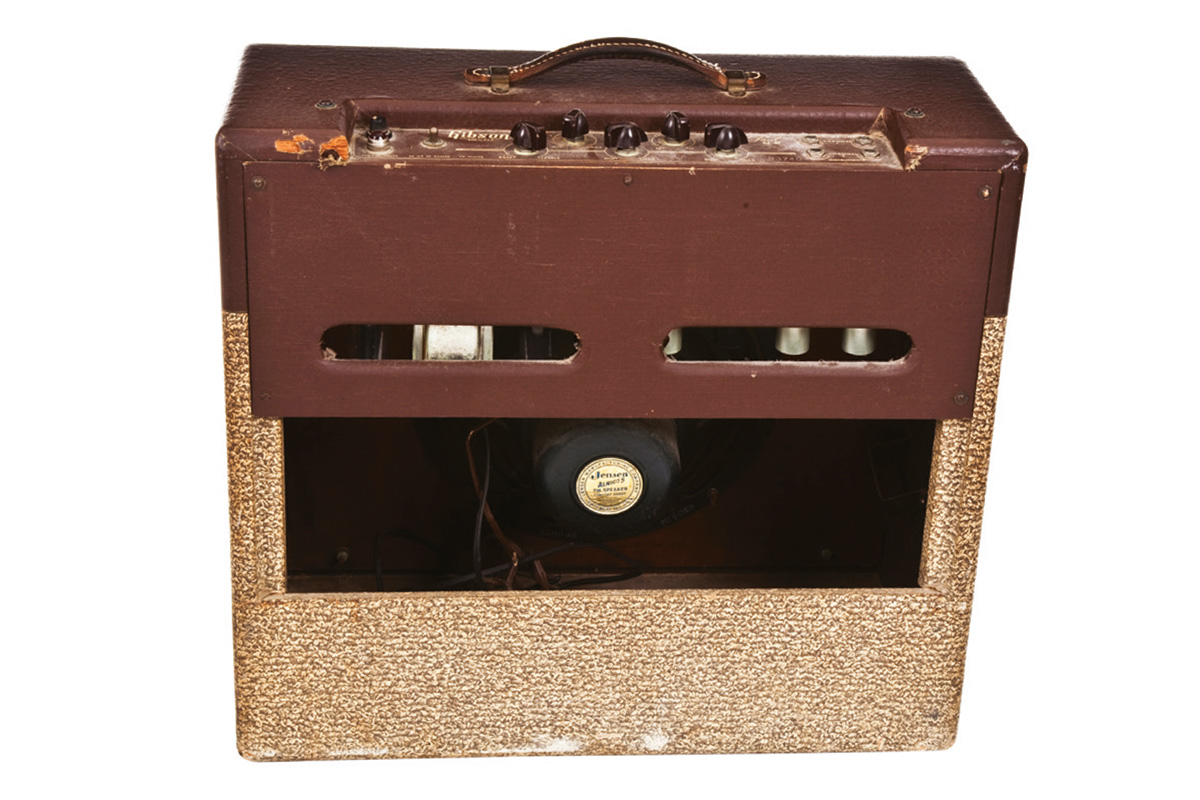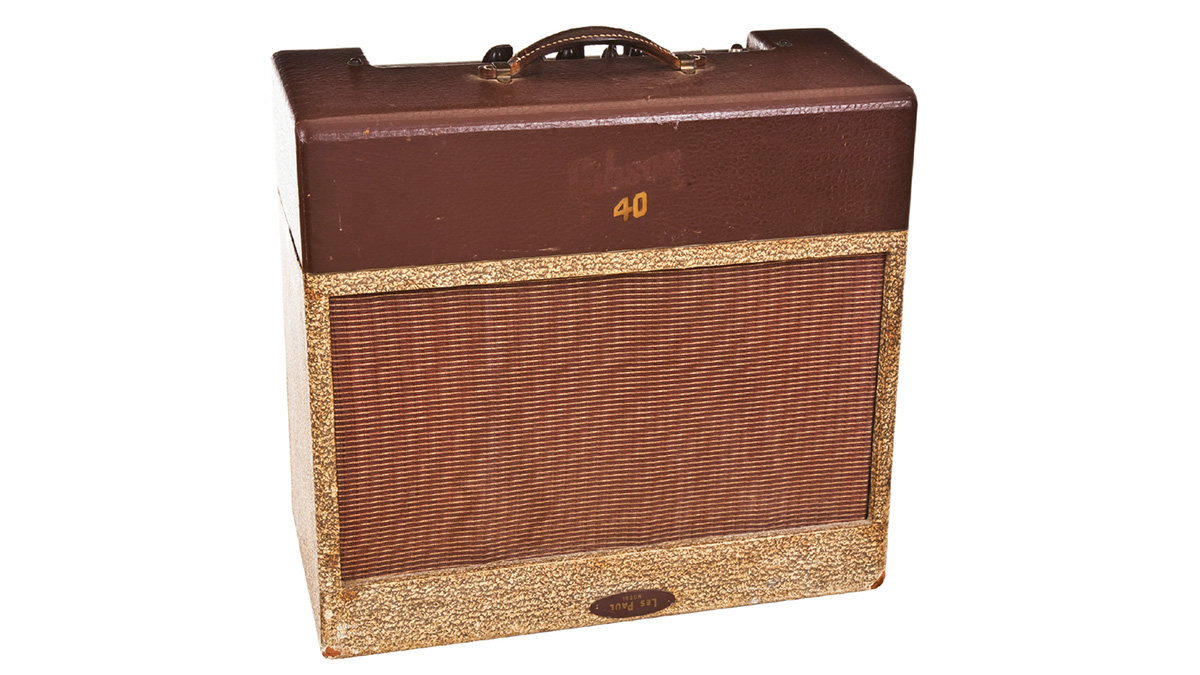Classic Gear: Gibson Les Paul GA-40 Amp
How can you acquire a genuine 1950s Gibson Les Paul for 1/50th – 1/100th the price of the iconic vintage guitar? By buying the amp, of course!

How can you acquire a genuine 1950s Gibson Les Paul for one-fiftieth to one-hundredth the price of the iconic vintage guitar? By buying the amp, of course! Like most comparable manufacturers of the day, Gibson often partnered electric guitars and amplifiers as “sets.”
The 1x12 GA-40 Les Paul amp debuted in 1952 alongside the signature goldtop guitar, and remained in the catalog until late 1962 or early ’63, when Les Paul terminated his deal with Gibson and the radically altered, double-cutaway guitar of the early ’60s became simply the SG.
While few vintage amps have attained the values of the better-known guitars that were their contemporaries, the GA-40 Les Paul is an interesting and desirable combo that has become something of a classic in its own right in recent years.
As the leaders in guitar amplification in the ’50s and early ’60s, Fender and Gibson exhibited great pride in their own original designs and never seemed to chase each other’s success with copies or wannabe amps
It’s all too easy to look at any vaguely similar ’50s guitar combo with a top-mounted control panel and say, “Oh, it’s a tweed Deluxe, only a little bigger and with tremolo.” In reality, the GA-40’s circuit and construction make it almost nothing like Fender’s ubiquitous 5E3 of the late ’50s, other than in its use of two 6V6GT output tubes and a 12-inch speaker.
The truth is, as the leaders in guitar amplification in the ’50s and early ’60s, Fender and Gibson exhibited great pride in their own original designs and never seemed to chase each other’s success with copies or wannabe amps.
For many contemporary players who have enjoyed the sonic charms of the most popular rendition of the GA-40 from the mid to late ’50s, the rather unusual 5879 preamp tube plays a big part in forming the amp’s unique character.

Rather than being a dual-triode tube like the more common 12AX7 and its brethren, the 5879 is a pentode, which means it uses five elements within the tube to get the amplification job done, much like many output tubes, rather than merely three.
All the latest guitar news, interviews, lessons, reviews, deals and more, direct to your inbox!
As such, it’s akin to the EF86/6267 pentode preamp tube famously included in the ’60s Vox AC15 and revived in many boutique amps by Dr. Z, Matchless, TopHat, 65amps, and others – although the two are also slightly different and have different pin connections, so don’t try replacing one for the other.
What really matters, though, is the bountiful goods the 5879 delivers tonally. Whereas the familiar 12AX7 leans bright, is a bit biting, and goes slightly fizzy in the high end as it starts to break up, the 5879 is thick, meaty, rich, and bold.

Like the EF86, it also has more gain than the 12AX7, but that isn’t saying its use indicates a high-gain circuit, by any means.
Instead, this pentode in the preamp helps to ensure that a full, stout signal is passed along to further stages of the amp, and that the guitar tone doesn’t easily fold over into mush within the preamp stage itself. What does all this translate to when you plug your guitar of choice into the front of a good GA-40 and let it rip?
Like the 5879 preamp tube, the Les Paul combo leans into a rich, thick, meaty, and predominantly warm tone, but with enough clarity and definition to help individual notes cut through
Like the 5879 preamp tube, the Les Paul combo leans into a rich, thick, meaty, and predominantly warm tone, but with enough clarity and definition to help individual notes cut through – at least relative to the general performance of amps from that era.
When pushed into overdrive, it exudes a throaty growl that makes it a great lead amp for trenchant blues, roots rock, or garage rock, and really packs a lot of girth around the notes.
The 5879 also has the benefit of being less microphonic than the EF86 pentode, which is infamously prone to rattle noise and other detrimental sonic artifacts after being subject to too much vibration (when used in a combo, in particular). This, alongside its sonic features, is one reason Fred Taccone of Divided by 13 embraces the 5879 in the 21st century.
In addition to its core tonality, the GA-40 has a great tremolo circuit, driven by an odd eight-pin 6SQ7 tube. Looking something like a stubby 6V6GT, the 6SQ7 actually packs a triode and two diodes within one shell, although only the former is used in the GA-40’s tremolo, which delivers a lush, atmospheric rendition of that popular effect.
The GA-40 Les Paul amp evolved both cosmetically and electronically through the 10 years of its existence. The debutante combo arrived in 1952 with a fancy grille cover with fretwork, a single channel with multiple inputs, and somewhat different complements in both features and tubes (the latter including three octal 6SJ7s and one 6SN7).
The most popular rendition – which we’re mostly discussing here – settled into itself around 1955, when a slightly taller cabinet emerged, still covered in two-tone cosmetics but with chocolate-brown covering on the upper section and something resembling a photo print of tan rug fibers adorning the lower three-quarters or so.
A couple years further into its run, the Les Paul amp adopted a more standard tweed covering over the lower portion of the cabinet, with a darker brown buffalo-grain material on the upper quarter.
The GA-40’s desirability has led to escalating prices over the past decade and a half, so they aren’t quite the easy-money finds they used to be
In 1960, the cabinet featured a full-frontal grille cloth, with a diagonal tweed – similar to that used by Fender for most of the ’50s – covering the rest of the box. Shortly afterward, the official model name changed to GA-40T, following a nomenclature Gibson used to denote its tremolo-equipped amps. The Les Paul combo disappeared entirely after 1962.
The GA-40’s desirability has led to escalating prices over the past decade and a half, so they aren’t quite the easy-money finds they used to be. The sibling-brand Maestro GA-45T accordion and bass combo of the late ’50s has a similar circuit, driven through an odd 4x8 speaker configuration that can easily be swapped out for a 1x12 baffle, and it is usually less expensive on the used market.
If you’re looking for the general sound and look in a newer creation, Victoria calls its Electro King combo “an idealized recreation of the classic McCarty-era GA-40.” Either way, it’s a fat, juicy rendition of the ’50s tweed tone that’s worth tasting, if you get the chance.
Dave Hunter is a writer and consulting editor for Guitar Player magazine. His prolific output as author includes Fender 75 Years, The Guitar Amp Handbook, The British Amp Invasion, Ultimate Star Guitars, Guitar Effects Pedals, The Guitar Pickup Handbook, The Fender Telecaster and several other titles. Hunter is a former editor of The Guitar Magazine (UK), and a contributor to Vintage Guitar, Premier Guitar, The Connoisseur and other publications. A contributing essayist to the United States Library of Congress National Recording Preservation Board’s Permanent Archive, he lives in Kittery, ME, with his wife and their two children and fronts the bands A Different Engine and The Stereo Field.

